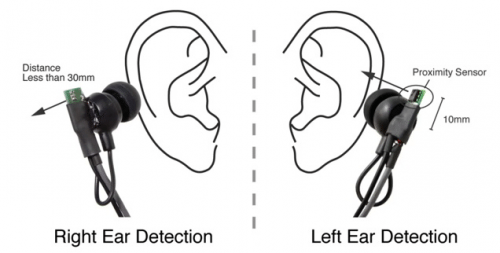 Isn’t it a pain when you have to look at your earbuds to work out which one’s left and which one’s right ? Or you find that you’ve had the wrong phone in the wrong ear ? Well the Japan Science and Technology Agency ( JST ) has a solution with their Universal Earphones. Using a proximity sensor the Universal Earphones automatically detect which ear each phone is in so that you’ll never have to worry about your stereo seperation again. In addition if you share earphones (something that all teenagers seem to do), then the phones will detect this do and put a full mono stream into each earphone rather than just a single channel. See the video after the jump.
Isn’t it a pain when you have to look at your earbuds to work out which one’s left and which one’s right ? Or you find that you’ve had the wrong phone in the wrong ear ? Well the Japan Science and Technology Agency ( JST ) has a solution with their Universal Earphones. Using a proximity sensor the Universal Earphones automatically detect which ear each phone is in so that you’ll never have to worry about your stereo seperation again. In addition if you share earphones (something that all teenagers seem to do), then the phones will detect this do and put a full mono stream into each earphone rather than just a single channel. See the video after the jump.
Universal Earphones: Earphones with Automatic Side and Shared Use Detection from Kohei Matsumura on Vimeo.



Gadgeteer Comment Policy - Please read before commenting
Really? All that engineering just overcome the issue of not remembering what we learned in PRESCHOOL?
What you learned in preschool is to share. And these also have the feature of mixing both channels when you are sharing with another person. 😉
The other aspect is that many earphones these days use the same unit for the left and the right. They are completely symmetric, have only a silk-screened marking to differentiate, and I get them incorrect almost every time when using them in the dark. (I usually score of the earphones with a knife so that I can figure out L/R by touch.) JVC makes asymmetric earphones, and that is one (small) reason why I prefer their products.
I’ve been kicking this around for some years and this article begs me to ask the question: Does it really matter which earphone you have in which ear?
I’m not asking to be funny or anything like that. I just want someone- a professional would be nice- to answer this for me and also explain why.
Thanks…
It’s usually the best to be able to tell which earbud is left/right for classical or binaural recordings, because in classical, the violins are usually on the left, violas in both, celli and basses on the right. In binaural recordings, they manipulate the aural pillar, or a person’s perception of sound location, to make the sound seem in front of you, behind you, far away from you, etc.
@Chris Thanks!
Been waiting for someone to reply to this.
It makes sense on the classical- My friend also told me that it is what the artist intends for you to hear.
So if I didn’t know that the violins were to be to the left I wouldn’t know I had the earphones on right or wrong?
Now binaural recordings would be like a recording of a race car coming from one side and going to the other. If I had the earphones reversed it would just come from the opposite side, wouldn’t it?
Again Chris, thank you for your response 🙂